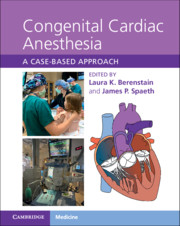Book contents
- Congenital Cardiac Anesthesia
- Congenital Cardiac Anesthesia
- Copyright page
- Dedication
- Contents
- Contributors
- Introduction
- Chapter 1 A Congenital Heart Disease Primer
- Section 1 Left-to-Right Shunts
- Section 2 Right-Sided Obstructive Lesions
- Section 3 Left-Sided Obstructive Lesions
- Section 4 Complex Mixing Lesions
- Section 5 Single-Ventricle Physiology
- Section 6 Heart Failure, Mechanical Circulatory Support, and Transplantation
- Section 7 Miscellaneous Lesions and Syndromes
- Chapter 40 Idiopathic Pulmonary Hypertension
- Chapter 41 Pulmonary Hypertension and Congenital Heart Disease
- Chapter 42 Pulmonary Hypertension and Prematurity
- Chapter 43 Pulmonary Hypertension and Moyamoya Disease
- Chapter 44 Vascular Ring
- Chapter 45 Pericardial Effusion
- Chapter 46 Kawasaki Disease
- Chapter 47 VACTERL Syndrome
- Chapter 48 Hurler Syndrome
- Chapter 49 Long QT Syndrome
- Chapter 50 Marfan Syndrome
- Index
- References
Chapter 45 - Pericardial Effusion
from Section 7 - Miscellaneous Lesions and Syndromes
Published online by Cambridge University Press: 09 September 2021
- Congenital Cardiac Anesthesia
- Congenital Cardiac Anesthesia
- Copyright page
- Dedication
- Contents
- Contributors
- Introduction
- Chapter 1 A Congenital Heart Disease Primer
- Section 1 Left-to-Right Shunts
- Section 2 Right-Sided Obstructive Lesions
- Section 3 Left-Sided Obstructive Lesions
- Section 4 Complex Mixing Lesions
- Section 5 Single-Ventricle Physiology
- Section 6 Heart Failure, Mechanical Circulatory Support, and Transplantation
- Section 7 Miscellaneous Lesions and Syndromes
- Chapter 40 Idiopathic Pulmonary Hypertension
- Chapter 41 Pulmonary Hypertension and Congenital Heart Disease
- Chapter 42 Pulmonary Hypertension and Prematurity
- Chapter 43 Pulmonary Hypertension and Moyamoya Disease
- Chapter 44 Vascular Ring
- Chapter 45 Pericardial Effusion
- Chapter 46 Kawasaki Disease
- Chapter 47 VACTERL Syndrome
- Chapter 48 Hurler Syndrome
- Chapter 49 Long QT Syndrome
- Chapter 50 Marfan Syndrome
- Index
- References
Summary
Pericardial effusions in children have multiple causes and variable presentations. Cardiac tamponade occurs when the heart chambers become externally compressed and ultimately cardiac output is compromised. The classical signs of cardiac tamponade include jugular venous distention, muffled heart sounds, and systemic hypotension (“Beck’s triad”); however, these are rarely all present. As cardiac output is dependent on preload and heart rate, the anesthetic goal is to avoid cardiac depression, maintain sympathetic outflow, and avoid a decrease in preload. If the effusion is amenable to percutaneous drainage, ideal anesthetic management includes sedation and analgesia with local anesthetic, while keeping the patient spontaneously breathing. If an open procedure is required, it is advisable to perform a “staged” anesthetic and surgical approach in which sedation, analgesia, and local anesthetic are administered to drain the effusion percutaneously before inducing general anesthesia and starting positive-pressure ventilation. As in most emergency situations, the risks of pulmonary aspiration and the chosen anesthetic techniques must be weighed against the urgency of intervention.
Keywords
- Type
- Chapter
- Information
- Congenital Cardiac AnesthesiaA Case-based Approach, pp. 345 - 351Publisher: Cambridge University PressPrint publication year: 2021



